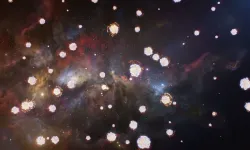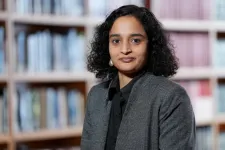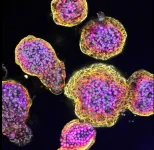(Press-News.org) Using ESO’s Very Large Telescope (VLT), researchers have found for the first time the fingerprints left by the explosion of the first stars in the Universe. They detected three distant gas clouds whose chemical composition matches what we expect from the first stellar explosions. These findings bring us one step closer to understanding the nature of the first stars that formed after the Big Bang.
“For the first time ever, we were able to identify the chemical traces of the explosions of the first stars in very distant gas clouds,” says Andrea Saccardi, a PhD student at the Observatoire de Paris - PSL, who led this study during his master’s thesis at the University of Florence.
Researchers think that the first stars that formed in the Universe were very different from the ones we see today. When they appeared 13.5 billion years ago, they contained just hydrogen and helium, the simplest chemical elements in nature [1]. These stars, thought to be tens or hundreds of times more massive than our Sun, quickly died in powerful explosions known as supernovae, enriching the surrounding gas with heavier elements for the first time. Later generations of stars were born out of that enriched gas, and in turn ejected heavier elements as they too died. But the very first stars are now long gone, so how can researchers learn more about them? “Primordial stars can be studied indirectly by detecting the chemical elements they dispersed in their environment after their death,” says Stefania Salvadori, Associate Professor at the University of Florence and co-author of the study published today in the Astrophysical Journal.
Using data taken with ESO’s VLT in Chile, the team found three very distant gas clouds, seen when the Universe was just 10–15% of its current age, and with a chemical fingerprint matching what we expect from the explosions of the first stars. Depending on the mass of these early stars and the energy of their explosions, these first supernovae released different chemical elements such as carbon, oxygen and magnesium, which are present in the outer layers of stars. But some of these explosions were not energetic enough to expel heavier elements like iron, which is found only in the cores of stars. To search for the telltale sign of these very first stars that exploded as low energy supernovae, the team therefore looked for distant gas clouds poor in iron but rich in the other elements. And they found just that: three faraway clouds in the early Universe with very little iron but plenty of carbon and other elements — the fingerprint of the explosions of the very first stars.
This peculiar chemical composition has also been observed in many old stars in our own galaxy, which researchers consider to be second-generation stars that formed directly from the ‘ashes’ of the first ones. This new study has found such ashes in the early Universe, thus adding a missing piece to this puzzle. “Our discovery opens new avenues to indirectly study the nature of the first stars, fully complementing studies of stars in our galaxy,” explains Salvadori.
To detect and study these distant gas clouds, the team used light beacons known as quasars — very bright sources powered by supermassive black holes at the centres of faraway galaxies. As the light from a quasar travels through the Universe, it passes through gas clouds where different chemical elements leave an imprint on the light.
To find these chemical imprints, the team analysed data on several quasars observed with the X-shooter instrument on ESO’s VLT. X-shooter splits light into an extremely wide range of wavelengths, or colours, which makes it a unique instrument with which to identify many different chemical elements in these distant clouds.
This study opens new windows for next generation telescopes and instruments, like ESO’s upcoming Extremely Large Telescope (ELT) and its high-resolution ArmazoNes high Dispersion Echelle Spectrograph (ANDES). “With ANDES at the ELT we will be able to study many of these rare gas clouds in greater detail, and we will be able to finally uncover the mysterious nature of the first stars,” concludes Valentina D’Odorico, a researcher at the National Institute of Astrophysics in Italy and co-author of the study.
Notes
[1] Minutes after the Big Bang the only elements present in the Universe were the three lightest ones: hydrogen, helium and very small traces of lithium. Heavier elements were formed much later on in stars.
More information
This research was presented in a paper to appear in the Astrophysical Journal (doi: 10.3847/1538-4357/acc39f)
The team is composed of Andrea Saccardi (GEPI, Observatoire de Paris, Université PSL, CNRS, France; Dipartimento di Fisica e Astronomia, University of Florence, Italy [UFlorence]), Stefania Salvadori (UFlorence; INAF – Osservatorio Astrofisico di Arcetri, Italy), Valentina D’Odorico (Scuola Normale Superiore, Italy; INAF – Osservatorio Astrofisico di Trieste, Italy [INAF Trieste]; IFPU – Institute for Fundamental Physics of the Universe, Italy [IFPU]), Guido Cupani (INAF Trieste; IFPU), Michele Fumagalli (Dipartimento di Fisica G. Occhialini, University of Milano Bicocca, Italy; INAF Trieste), Trystyn A. M. Berg (Dipartimento di Fisica G. Occhialini, University of Milano Bicocca, Italy), George D. Becker (Department of Physics & Astronomy, University of California, USA), Sara Ellison (Department of Physics & Astronomy, University of Victoria, Canada), Sebastian Lopez (Departamento de Astronomía, Universidad de Chile, Chile).
The European Southern Observatory (ESO) enables scientists worldwide to discover the secrets of the Universe for the benefit of all. We design, build and operate world-class observatories on the ground — which astronomers use to tackle exciting questions and spread the fascination of astronomy — and promote international collaboration in astronomy. Established as an intergovernmental organisation in 1962, today ESO is supported by 16 Member States (Austria, Belgium, the Czech Republic, Denmark, France, Finland, Germany, Ireland, Italy, the Netherlands, Poland, Portugal, Spain, Sweden, Switzerland and the United Kingdom), along with the host state of Chile and with Australia as a Strategic Partner. ESO’s headquarters and its visitor centre and planetarium, the ESO Supernova, are located close to Munich in Germany, while the Chilean Atacama Desert, a marvellous place with unique conditions to observe the sky, hosts our telescopes. ESO operates three observing sites: La Silla, Paranal and Chajnantor. At Paranal, ESO operates the Very Large Telescope and its Very Large Telescope Interferometer, as well as survey telescopes such as VISTA. Also at Paranal ESO will host and operate the Cherenkov Telescope Array South, the world’s largest and most sensitive gamma-ray observatory. Together with international partners, ESO operates ALMA on Chajnantor, a facility that observes the skies in the millimetre and submillimetre range. At Cerro Armazones, near Paranal, we are building “the world’s biggest eye on the sky” — ESO’s Extremely Large Telescope. From our offices in Santiago, Chile we support our operations in the country and engage with Chilean partners and society.
Links
Research paper
Photos of the VLT
For journalists: subscribe to receive our releases under embargo in your language
For scientists: got a story? Pitch your research
Contacts
Andrea Saccardi
GEPI, Observatoire de Paris, Université PSL, CNRS
Paris, France
Cell: +39 3408796870
Email: andrea.saccardi@observatoiredeparis.psl.eu
Stefania Salvadori
University of Florence
Florence, Italy
Tel: +39 055 2755222
Email: stefania.salvadori@unifi.it
Valentina D’Odorico
INAF Osservatorio Astronomico di Trieste
Trieste, Italy
Tel: +39 040 3199217
Email: valentina.dodorico@inaf.it
Juan Carlos Muñoz Mateos
ESO Media Officer
Garching bei München, Germany
Tel: +49 89 3200 6176
Email: press@eso.org
END
Astronomers find distant gas clouds with leftovers of the first stars
2023-05-03
ELSE PRESS RELEASES FROM THIS DATE:
Sleep phase can reduce anxiety in people with PTSD
2023-05-03
A new study shows that sleep spindles, brief bursts of brain activity occurring during one phase of sleep and captured by EEG, may regulate anxiety in people with post-traumatic stress disorder (PTSD).
The study shines a light on the role of spindles in alleviating anxiety in PTSD as well as confirms their established role in the transfer of new information to longer-term memory storage. The findings challenge recent work by other researchers that has indicated spindles may heighten intrusive and violent thoughts in people with PTSD.
The final draft of the preprint publishes in Biological Psychiatry: Cognitive Neuroscience and Neuroimaging on ...
New investigators join Stowers Institute for Medical Research
2023-05-03
KANSAS CITY, MO—May 3, 2023—The Stowers Institute for Medical Research announced the hiring of three principal investigators to further expand its team of scientists who seek to answer life’s biggest mysteries through foundational research. Siva Sankari, Ph.D., from Massachusetts Institute for Technology, Neşet Özel, Ph.D., from New York University, and Ameya Mashruwala, Ph.D., from Princeton University, will join the Institute’s current team of 17 principal investigators and staff of 500. The addition of these scientists ...
The biophysicist names Padmini Rangamani as new Editor-in-Chief
2023-05-03
ROCKVILLE, MD – The Biophysical Society is pleased to announce that Padmini Rangamani of the University of California, San Diego has been named as the new Editor-in-Chief of the The Biophysicsist, the Society’s open access education journal. The journal was developed under the leadership and vision of founding and current Editor-in-Chief, Sam Safran of the Weizmann Institute of Science in Rehovot, Israel, to highlight and nurture biophysics education and its scholarship and development.
“Now, more than ever, is the time for an education journal such as The Biophysicist to steer the ...
Gender gap found in research grant award amounts, re-applications
2023-05-03
VANCOUVER, Wash. – Women researchers received substantially less funding in grant awards than men—an average of about $342,000 compared to men’s $659,000, according to a large meta-analysis of studies on the topic.
Women were also less likely to receive second grants to continue their research. In first-time grant applications, proportional numbers of women and men scientists were approved for funding, but for re-applications, 9% fewer women who applied were approved than their male ...
Steep 66% drop in party registration with Automatic Voter Registration
2023-05-03
In 2016, Oregon became the first state to adopt and implement an Automatic Voter Registration (AVR) system. Now, twenty-two states, plus Washington D.C., have such systems in place. Early research on the impacts of this innovation has shown an increase in the number of people registered, and greater diversity among the registrants.
Now, a researcher using Oregon voter data has identified an unintended consequence of Automatic Voter Registration: a steep drop in party registration. These results have been published in the journal Electoral Studies ...
New insights into liver cancer using organoids
2023-05-03
PRESS RELEASE: PRINCESS MÁXIMA CENTER FOR PEDIATRIC ONCOLOGY
EMBARGO: WEDNESDAY 3 MAY 2023 AT 10:00AM BST (11:00AM CEST)
Scientists of the Princess Máxima Center for pediatric oncology and Hubrecht Institute in the Netherlands have revealed new scientific insights into the features of fibrolamellar carcinoma (FLC), a rare type of childhood liver cancer. Their findings, published today in Nature Communications, may help in developing new drug therapies in the future. Mini organs and the ‘molecular scissor’ system CRISPR-Cas9, allowed the researchers to better understand tumor biology and biological ...
Can low-carbohydrate or low-fat diets prolong life in middle-aged and older adults?
2023-05-03
Short-terms clinical trials have demonstrated the health benefits of low-carbohydrate diets (LCDs) and low-fat diets (LFDs) for weight loss and heart protection. Now a study published in the Journal of Internal Medicine looks at the effects of these diets on mortality in middle-aged and older adults.
In the study of 371,159 individuals aged 50 to 71 years, 165,698 deaths occurred over a median follow-up of 23.5 years.
A healthy LFD—characterized by low intake of saturated fat and high intakes of plant protein and high-quality carbohydrates—was related to fewer deaths from all causes, from cardiovascular diseases, and from cancers. In ...
Research reveals an increase in the range of invasive American mink in Europe
2023-05-03
The American mink Neogale vison is an invasive species in Europe introduced for fur farming in the 1920s and later established in the wild after escapes and illegal releases. As a feral species, it threatens native species and biodiversity, and poses a risk for boosting disease circulation, including mink-related strains of COVID-19. New research published in Mammal Review provides information on the presence of the species in Europe over the past 15 years.
The study, which was conducted by an international team of scientists, compiled a diverse set of data resources covering 32 nations. The work uncovers a progressive spread of the American mink in most ...
Can internet usage help protect against dementia?
2023-05-03
New research published in the Journal of the American Geriatrics Society found a link between regular use of the internet and a lower risk of dementia.
For the study, investigators followed 18,154 dementia-free adults aged 50 to 64.9 years for a median of 7.9 years and a maximum of 17.1 years. During follow-up, 4.68% of participants were diagnosed with dementia.
Regular internet usage was associated with approximately half the risk of dementia compared with non-regular usage. This link was found regardless of educational attainment, race-ethnicity, sex, and generation.
“Online engagement may help to develop and maintain cognitive reserve, which ...
How well do face masks worn by children block the release of exhaled particles?
2023-05-03
New research published in Pediatric Investigation provides evidence that face masks reduce the release of exhaled particles when used by school-aged children.
For the study, 23 healthy children were asked to perform activities that ranged in intensity (breathe quietly, speak, sing, cough, and sneeze) while wearing no mask, a cloth mask, or a surgical mask.
The production of exhaled particles that were 5 μm or smaller, which is the dominant mode of transmission of many respiratory viruses, increased with coughing and sneezing. Face masks—especially surgical face masks—effectively reduced the release of ...



